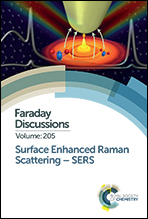The theory of surface-enhanced Raman scattering on semiconductor nanoparticles; toward the optimization of SERS sensors
Abstract
We present an expression for the lowest order nonzero contribution to the surface-enhanced Raman spectrum obtained from a system of a molecule adsorbed on a semiconductor nanoparticle. Herzberg–Teller vibronic coupling of the zero-order Born–Oppenheimer states results in an expression which may be regarded as an extension of the Albrecht A-, B-, and C-terms to SERS substrates. We show that the SERS enhancement is caused by combinations of several types of resonances in the combined system, namely, surface, exciton, charge-transfer, and molecular resonances. These resonances are coupled by terms in the numerator, which provide selection rules that enable various tests of the theory and predict the relative intensities of the Raman lines. Furthermore, by considering interactions of the various contributions to the SERS enhancement, we are able to develop ways to optimize the enhancement factor by tailoring the semiconductor nanostructure, thereby adjusting the locations of the various contributing resonances. This provides a procedure by which molecular sensors can be constructed and optimized. We provide several experimental examples on substrates such as monolayer MoS2 and GaN nanorods.
- This article is part of the themed collection: Surface Enhanced Raman Scattering - SERS


 Please wait while we load your content...
Please wait while we load your content...